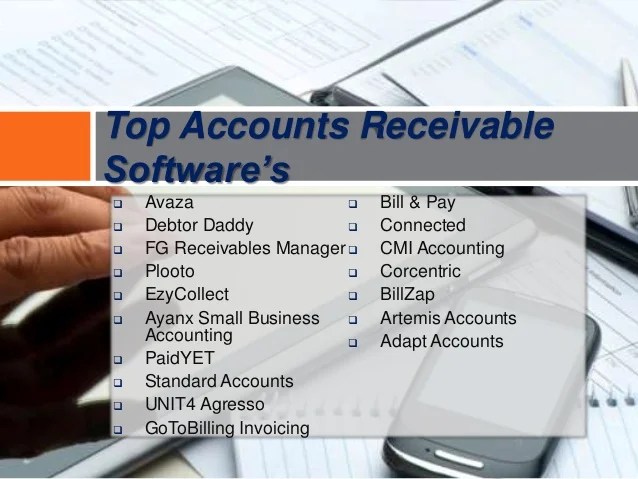✓ Accounts Receivable Vs Payable
- Dapatkan link
- X
- Aplikasi Lainnya
✓ Accounts Receivable Vs Payable. Accounts receivable is an asset account. Accounts payable is typically a credit account, which means that the total reflects money that is flowing out of the business.

For accounts receivables, the accountability lies on the debtors, while for account payables, the accountability lies on the business. Accounts payable is the amount that a business or a company owes to its suppliers. The difference between an account receivable and an account payable is that one is for money owed to your business by clients or vendors, while the other is for money you owe to those same entities. Accounts payable is the amount which a person owes to the creditors, whereas the accounts receivable is the amount that a business should receive from its debtors. Video on accounts receivable vs.
Converting Accounts Receivable to Notes Receivable Professor Victoria

Converting Accounts Receivable to Notes Receivable Professor Victoria from www.youtube.com. This total is typically given as a positive number. Accounts payable are the amounts that a company has to pay for the goods or services it had brought. Accounts receivable is the amount that a company has to get for the goods and services that it had sold.
5 rows the first step to understanding the difference is to know the definitions: The two types of accounts are very similar in the way they are recorded, but it is important to differentiate between accounts payable vs accounts receivable because one of them is an asset account and. On the one side, your accounts receivable is a current asset on your balance sheet because it’s money you’ll soon be receiving from customers or clients. When you buy something on credit, make accounts payable entry. If you're on a galaxy fold, consider unfolding your phone or viewing it in full screen to best optimize your experience.
This total is typically given as a positive number. The money that a company would receive from its debtors in the future is accounts receivable. Here's how to use them to keep your small business running smoothly. Receivables usually only involve a single trade receivables account. The two types of accounts are very similar in the way they are recorded, but it is important to differentiate between accounts payable vs accounts receivable because one of them is an asset account and.
Difference between TDS Receivable and TDS Payable Chapter 8 TDS Rece

Difference between TDS Receivable and TDS Payable Chapter 8 TDS Rece from www.teachoo.com. However, there are the following major differences between the two: It is the amount of money a company can collect because it sold goods or services on credit to a customer. Furthermore, accounts receivable is considered a current asset, whereas accounts payable is considered a current liability.
Receivables usually only involve a single trade receivables account. The difference between an account receivable and an account payable is that one is for money owed to your business by clients or vendors, while the other is for money you owe to those same entities. Accounts receivables and accounts payables are two sides of the same cash flow coin. Accounts payable is the amount which a person owes to the creditors, whereas the accounts receivable is the amount that a business should receive from its debtors. Accounts payable vs accounts receivable.
Accounts receivables are analyzed by the average number of days to collect payment (called days sales outstanding or dso), and accounts payable are analyzed by the average number of days it takes to pay an invoice (days payable outstanding or dpo). The account payable results when credit purchases are made. On the one side, your accounts receivable is a current asset on your balance sheet because it’s money you’ll soon be receiving from customers or clients. Accounts payable are the amounts that a company has to pay for the goods or services it had brought. Accounts receivable (ar) is considered an asset to a company.
Accounts payable can be called as liabilities while the accounts receivable can be called as assets. When you purchase goods or services from a vendor on credit, the bill goes to ap to be paid. This total is typically given as a positive number.
Accounts payable (ap) is considered a liability to a company. ✓ Accounts Receivable Vs Payable. Accounts payable vs accounts receivable. Accounts receivable is an asset account. This will assist you in balancing your books.
✓ Accounts Receivable Vs Payable

Accounts receivable is an asset account. The total may be provided as a negative number. Cash flow impact of accounts payable vs.

The difference between an account receivable and an account payable is that one is for money owed to your business by clients or vendors, while the other is for money you owe to those same entities. Accounts payable (ap) handles paying what you owe, or your liabilities. Accounts payable (ap) is considered a liability to a company.

It is quick to deploy and ready to integrate with erps like oracle netsuite. The total may be provided as a negative number. The two types of accounts are very similar in the way they are recorded, but it is important to differentiate between accounts payable vs accounts receivable because one of them is an asset account and.

Furthermore, accounts receivable is considered a current asset, whereas accounts payable is considered a current liability. They keep track of the money that goes out of your business. The money that a company would receive from its debtors in the future is accounts receivable.

Receivables usually only involve a single trade receivables account. 5 rows the first step to understanding the difference is to know the definitions: When you purchase goods or services from a vendor on credit, the bill goes to ap to be paid.

Accounts receivable is an asset account. When it comes down to it, both accounts are needed in order to keep things running smoothly. And just like all asset accounts, it should have a debit balance:

Video on accounts receivable vs. Accounts payable is the amount which a person owes to the creditors, whereas the accounts receivable is the amount that a business should receive from its debtors. Receivables may be offset by an allowance for doubtful accounts, while payables have no such offset.

For accounts receivables, the accountability lies on the debtors, while for account payables, the accountability lies on the business. Where cogs is cost of goods sold and cogs/day is the daily average of purchases. Receivables are classified as a current asset, while payables are classified as a current liability.

Accounts payable is the amount which a person owes to the creditors, whereas the accounts receivable is the amount that a business should receive from its debtors. Following are the differences between accounts receivable vs accounts payable: When you buy something on credit, make accounts payable entry.
The Total May Be Provided As A Negative Number.
The difference between an account receivable and an account payable is that one is for money owed to your business by clients or vendors, while the other is for money you owe to those same entities. Following are the differences between accounts receivable vs accounts payable: Accounts payable accounts payable is an account containing all amounts that we owe.. ✓ Accounts Receivable Vs Payable
Account Payable Is Due On The Business Entity For The Outstanding Amounts Yet To Be Settled.
Cash flow impact of accounts payable vs. Accounts receivable represents money that your business owes to customers, and accounts payable represents money that you owe to suppliers. It is quick to deploy and ready to integrate with erps like oracle netsuite.. ✓ Accounts Receivable Vs Payable
And Just Like All Asset Accounts, It Should Have A Debit Balance:
Video on accounts receivable vs. Accounts payable is simply the total cost of purchases. Here's how to use them to keep your small business running smoothly.. ✓ Accounts Receivable Vs Payable
Accounts Receivables And Accounts Payables Are Two Sides Of The Same Cash Flow Coin.
Accounts payable are the amounts that a company has to pay for the goods or services it had brought. Accounts payable is the amount which a person owes to the creditors, whereas the accounts receivable is the amount that a business should receive from its debtors. When it comes down to it, both accounts are needed in order to keep things running smoothly.. ✓ Accounts Receivable Vs Payable
The Average Accounts Receivables Are Calculated As Beginning Balance Plus Ending Balance Divided By Two.
When you purchase goods or services from a vendor on credit, the bill goes to ap to be paid. Accounts payable (ap) is considered a liability to a company. Accounts payable is typically a credit account, which means that the total reflects money that is flowing out of the business.. ✓ Accounts Receivable Vs Payable
- Dapatkan link
- X
- Aplikasi Lainnya
Komentar
Posting Komentar